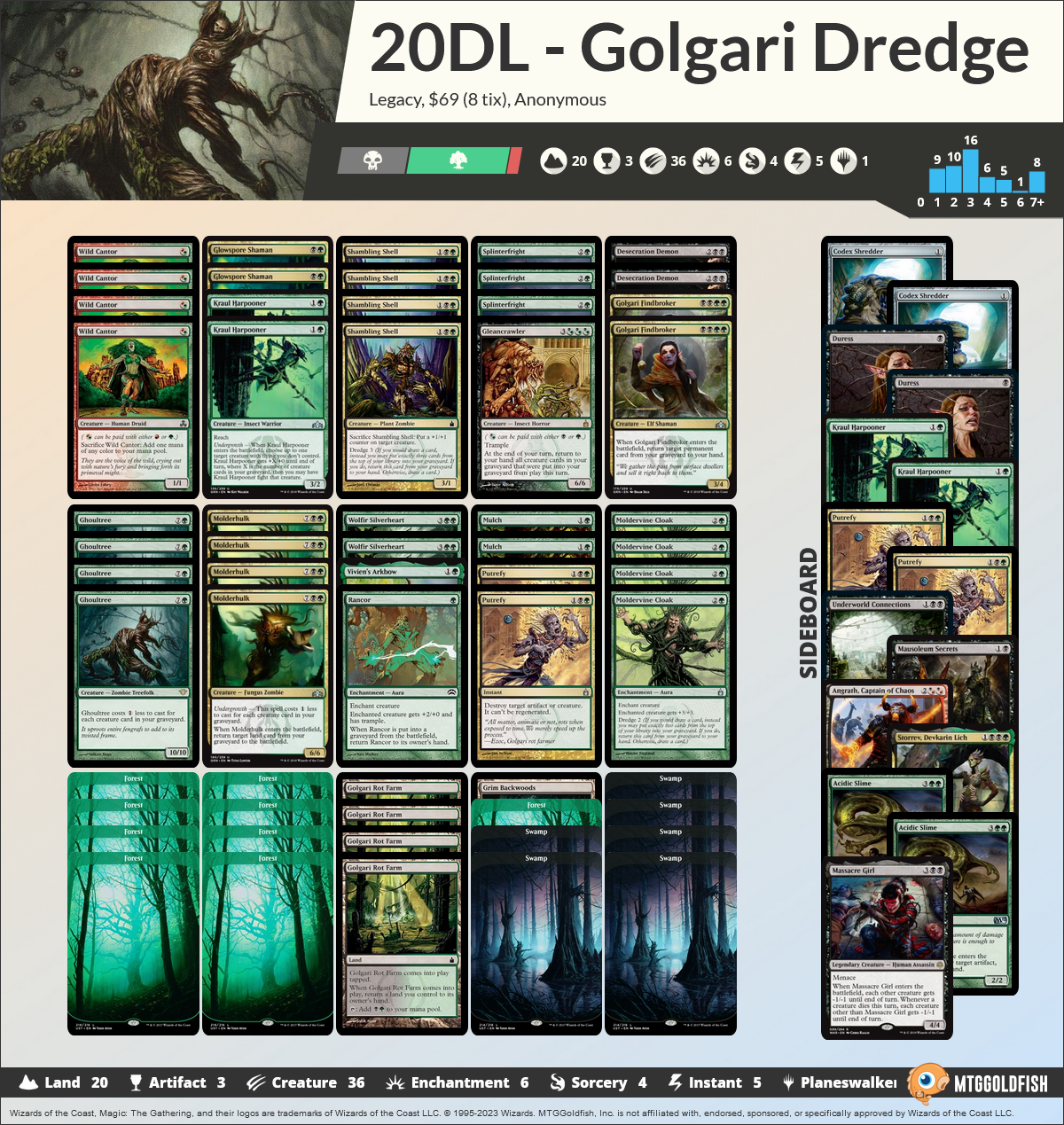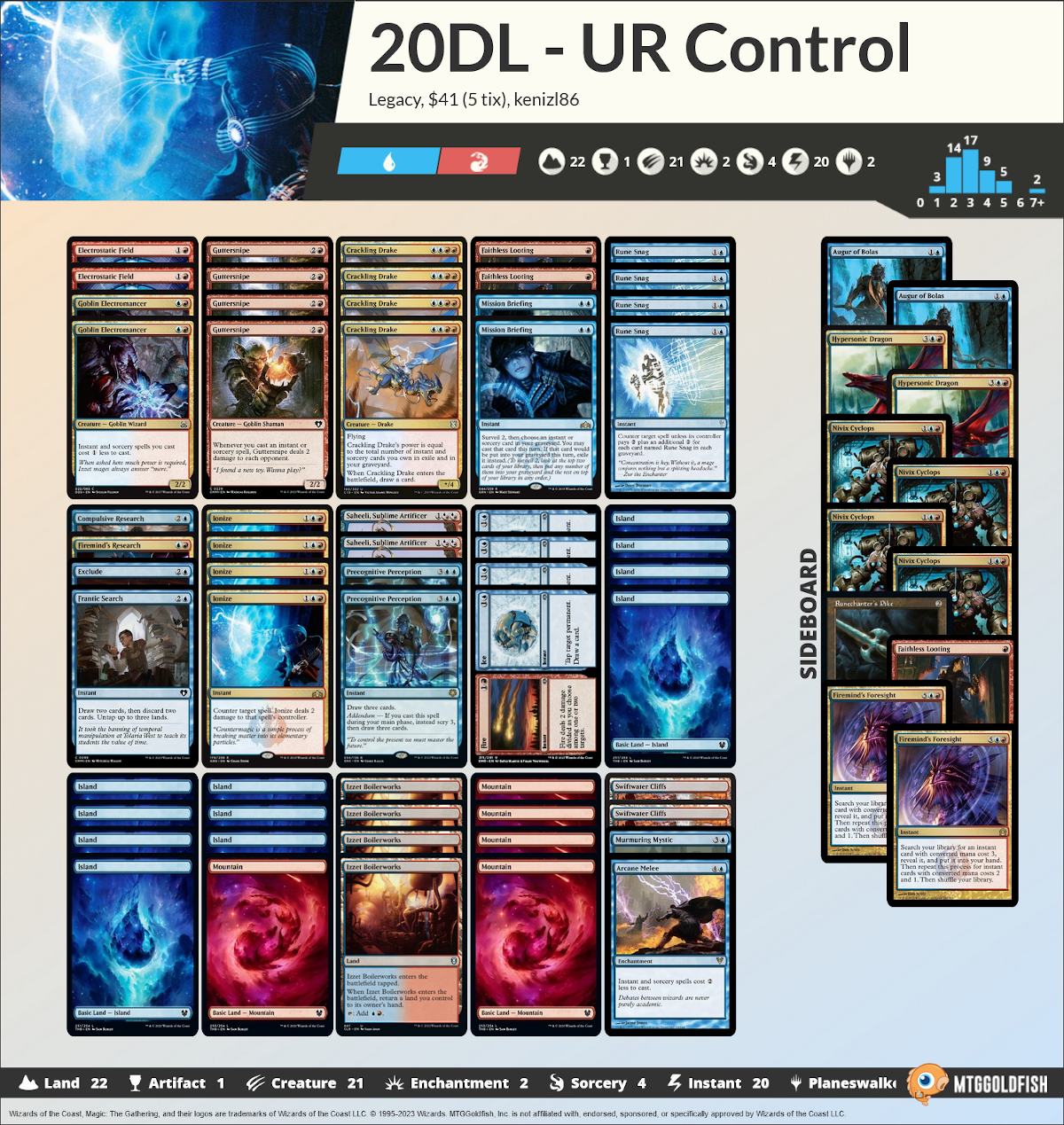MTG – The 20 Dollar League
Created: 11 Sep 2023Updated: 28 Nov 2023
So. You and your friends want to play MTG, but you can’t get into Standard, Modern, Legacy, or really any format that requires money? Are you inspired by the fun times had by people such as Loading Ready Run as they goof around with decks of similar janky power level? Do you wish you could be part of a fun format where you and a group of friends could play some POWERFUL MAGIC over the course of many games and keep it fun? Well, I can’t promise you any powerful magic, but I sure can introduce you to the 20 Dollar League (20DL for short, if you’re cool and short on time)!
Why and What is the 20DL?
The 20 Dollar League is a format idea I came up with after being inspired by the fun seen in the previously linked video (of which there are several of them) for me and my friend to play. It’s admittedly new, but I think it could have the potential to be quite a fun and interesting way to get new players (and old ones) interested in playing MTG on a budget!
For a while I was thinking of how my friend and I could have fun yet balanced games of Magic. It’s tough being a new player to the game and lacking the necessary tools to build decks that can stand with the best of them. Mind you, we’re not talking about Vintage or anything, but simply playing casual 1v1 games with a friend whose collection far outstrips yours can be quite disheartening and frankly frustrating at times. You could try and say “yeah, let’s do modern” but then one of you might already have 50% of a decent deck while the other is sitting there waiting to get $100 to buy a teir 3 deck (I don’t even know what teir 3 would look like, but I bet it’s janky as heck). Enter the 20 Dollar League.
Format Rules
The rules for the 20DL are quite simple:
- Legacy ban and restricted list
- 60 cards, 4 card playset (typical constructed)
- 15 card sideboard
- 20 life
- Each player’s starting deck and sideboard (excluding basic lands) must come to $20 or less before tax
- This format follows a loose structure of a League (more on that in the next sections)
You’ll note that this is basically just Legacy, but with the last two bullet-point stapled to the end of it. YUP. That’s exactly what it is.
I can hear you saying “gee, that’s dumb”, but hear me out. The idea of setting a STARTING budget is to put players on as even a keel as possible. Yes, cards can be underpriced and overpowered (take a look at some Pauper staples), but it’s not the same as you having a Bonesplitter and me with my Umezawa’s Jitte. Because you’ll likely be looking through the dollar rares and 25-cent uncommons, all players should be roughly looking at a similar price-dependant cardpool. Even if you do find something good, it can make for interesting games and be like “dang, you got that at the store?!”
The spirit of the second-to-final point is important. The idea is that all players in the league would choose a Local Game Store (LGS) to go to and all meetup there to brainstorm, brew, hunt and build your respective decks. This creates a fun, treasure-hunting atmosphere and bouncing ideas off the others in the league can be good fun (and a great way for new players to see what the deck-brewing process is all about). It also helps you guage what the other respective power levels will be.
On that note, don’t metadeck. That is not the spirit of this initial buy-in. The idea is to come up with a strategy, then build that strategy, then develop a generic sideboard for general issues your deck could run against. DONT build your deck or sideboard to specifically counter or destroy another person’s deck. This can seriously kill any fun in your games with that person. However, some metadecking is unavoidable, just keep it to a minimum; and in fact the Sideboard is a fine place to shore up your deck for the meta of your own league.
Speaking of deckbuilding…
The Decks
This next section is for people needing some guidance on how to navigate the first deck-building and brainstorming session at the LGS. While it’s beneficial to have a friend in the league who can help the others get their bearings, this section will hopefully be a good launchpad for those who need the help. I will be using examples from me and my friend’s excursion of our first treasure hunt to illustrate the thought-process of building a deck on the fly.
For me, I was already aware of typical draft strategies and the rough shape most color pairings tend towards for typical decks. I had a bit of a leg-up in this regard over my friend. I knew that from my recent forays into deckbuilding I was having a lot of fun experimenting with aggro decks (as my main go-to for the longest time was control, combo, or stax-ish), and specifically I was aware that Golgari (meaning Green/Black) aggro was particularly fun since it made ample use of the graveyard, which makes it more resilient. I also knew that Golgari graveyard strategies are pretty well supported across many sets for draft, so I would have a pretty good pool to choose from at the store. Of course, never keep your eggs in one basket is sage advice; so I also prepped some other ideas such as Boros (White/Red) equipment, Gruul (Red/Green) meanies, Dimir (Blue/Black) zombies, etc.
Meanwhile, my friend went the other direction. He had been building a lot of creature heavy decks like Mono-Green, Rakdos (Black/Red) aggro, Mardu (White/Black/Red) samurais; so he decided that he’d have a go at control. I talked to him about it and ultimately we decided that two colors was probably most likely to land us a decent pool of cards over going, say, Mono-Blue. He liked the idea of Counter-Burn (Izzet, which is Blue/Red control) over say Azorius Control (White/Blue).
After our discussions, we went to the game store where the hunt truly began.
The store we went to had the big drawers of sorting boxes sectioned by set, rather than by rarity or price. Knowing that both of us were looking at two Ravnica Guilds (Golgari for me and Izzet for my friend), we started to sift through the boxes. For me, the very first card I saw when I took out the box for Innistrad/Ravnica, was Ghoultree. IT WAS FATE. I decided “screw it, I guess I HAVE to build Golgari Dredge now”. I dug through all the boxes, and slowly began to whittle down to a workable deck until I arrived at what became my very first 20DL DECK:

Needless to say I was fairly pleased that I could assemble a fun enough deck for what came out to about $18.
Similarly, I was watching my friend as he was pulling cards for his deck. As I found cards I thought he’d like I was also pulling them out to help with his search. It took a while, but he eventually built the deck you see before you:

I know this wasn’t an in-depth guide to deckbuilding, rather I simply wanted to show you how your thought-processes should go as you sift through what is available at your store. It’s possible that unlike our experience, perhaps you had to pivot because the store didn’t have all the cards you wanted! I know I had to make a lot of concessions at the time because the store only had so many of a given card or none at all of a linchpin card for the deck. The point is, HAVE FUN!
Playing The League
Now that we had built our decks, it was time TO DO BATTLE!
The league plays out simply:
- Matches consist of Best of Three
- Each match win grants you 5 Points
- Each match loss grants you 3 Points
- Points work as dollar allotments, where points are spent to upgrade your decks
- The league organizer keeps track of all points spent and gained
So here’s how our first games went:
We went three games for each of our first two matches, where I was the victor
Kenny = 10pts (2/0)
Not-Kenny = 6pts (0/2)
We then took our respective points (me with my 10 and his of 6) and went off separately to buy our upgrades by spending the points we had accumulated. This is simple: either take a receipt of what you bought (not including tax), round up to the nearest dollar and subtract that amount from your available points; or use something like Moxfield to make a temporary deck and put in all the cards you’d like to upgrade to, note thier value, then round up to the nearest dollar and subtract from your available points.
In both cases, the idea is that the points allow for upgrades, and will go up and down as the league progresses. For example, after some upgrades and more matches, our current standing is thus:
Kenny = 6pts (2/2)
Not-Kenny = 11pts (2/2)
The numbers don’t really add up because, as stated before, we spent some of our points for upgrades and such. You can also tell that he’s been giving me a run for my money after my initial win streak! It’s definitely keeping the league interesting. Also, you can see my decklist as it’s evolved (through the use of the “history” feature in Moxfield) from the initial decklist here: 20DL - Golgari Dredge.